
[ Vol. 92 ]
MANA Develops Ferroelectric-ferromagnetic Materials for Next-generation Electronics
Scientists from the Research Center for Materials Nanoarchitectonics (MANA) have integrated machine learning with traditional materials science to expedite the discovery of kesterite-type thermoelectric materials, paving the way for efficient energy conversion technologies.

[ Vol. 91 ]
MANA Develops Ferroelectric-ferromagnetic Materials for Next-generation Electronics
Researchers at the Research Center for Materials Nanoarchitectonics (MANA) have proposed a method to create ferroelectric-ferromagnetic materials, opening doors to advancing spintronics and memory devices.

[ Vol. 90 ]
From Bottleneck to Breakthrough: MANA Achieves New Computing Paradigm with Reconfigurable Logic Circuits
Scientists from the Research Center for Materials Nanoarchitectonics (MANA) developed a reconfigurable logic circuit that switches functions with constant input voltages. This innovation opens doors to novel computing architectures.

[ Vol. 89 ]
Powering the Future Night and Day: MANA Develops Cutting-Edge Thermoelectric Generator
Researchers from the Research Center for Materials Nanoarchitectonics (MANA) have developed a thermoelectric generator that can use both radiative cooling and solar heating to produce electricity, opening doors to applications in powering small off-grid sensors.

[ Vol. 88 ]
Advancing Organic Circuits: MANA Study Changes Current Computing Architecture
Researchers from the Research Center for Materials Nanoarchitectonics (MANA) have developed a novel organic logic inverter circuit capable of handling four logical states. This advancement improves the data processing capabilities of organic integrated circuits.

[ Vol. 87 ]
MANA Scientists Usher in Advances in Thermoelectric Materials
Scientists from the Research Center for Materials Nanoarchitectonics (MANA) have now enhanced Mg3(Sb, Bi)2-based alloys with molybdenum, paving the way for materials that efficiently harness heat energy.

[ Vol. 86 ]
New Leap in Flexible Electronics: MANA's Breakthrough Doping Innovation
Researchers from the Research Center for Materials Nanoarchitectonics (MANA) have introduced a doping method to achieve accurate and consistent conductivity for organic semiconductors.

[ Vol. 85 ]
High-performance Physical Reservoir Computing with Multi-detection Chaotic Spin Wave Interference
Researchers from the Research Center for Materials Nanoarchitectonics (MANA) present the first experimental demonstration of a physical reservoir computing system based on spin wave interference.

[ Vol. 84 ]
Plasmaron Quasiparticles in Cuprate Superconductors
A team led by researcher at Research Center for Materials Nanoarchitectonics (MANA) delved into the interplay of plasma oscillations and electrons in cuprate superconductors, shedding light on the emergence of plasmarons -- distinct quasiparticles driven by charge fluctuations within the system.

[ Vol. 83 ]
Novel “Drycell” Microdroplets to Make Handling a Single Cell Easier
Scientists at MANA have developed micrometer-sized ‘liquid marbles’ that can encapsulate single to several living cells, thereby aiding single cell studies.

[ Vol. 82 ]
Demystifies Conductivity of Ruthenate Nanosheets, Moving Towards Next-generation Electronics
A research team at MANA has shed light on how electrical conduction in oxide nanosheets can be markedly affected by small changes in their atomic arrangement.

[ Vol. 81 ]
Towards Inexpensive and Highly Conductive Anion-Exchange Membranes
An international research team at MANA has worked to improve the ionic conductivity of anion-exchange membranes (AEMs) made from layered double hydroxides (LDHs), laying the foundation for their use in many electrochemical applications.

[ Vol. 80 ]
Novel, Biocompatible UV Light Absorber
An International research team at MANA has developed a biocompatible ultraviolet (UV) light-shielding compound from naturally occurring aqueous iron(III), hereinafter aqua-Fe(III), complexes stabilized inside a layered silicate scaffold.

[ Vol. 79 ]
Insight into Organic Antiambipolar Transistors
MANA researchers have elucidated the mechanism behind organic antiambipolar transistors (OAATs), a new class of transistors with possible applications in artificial intelligence and neuromorphic devices.

[ Vol. 78 ]
New Diamond Transistor Exhibits High Hole Mobility
A research team at MANA, using a new fabrication technique, has developed a diamond field-effect transistor with high hole mobility, which can lead to reduced conduction loss and higher operational speeds.

[ Vol. 77 ]
New TEM Technique Creates 2.8nm Transistor
An international research team at MANA has used a transmission electron microscope (TEM) to create a 2.8nm transistor consisting of nanochannels embedded in metallic carbon nanotubes (CNTs), which exhibits quantum transport at room temperature.

[ Vol. 76 ]
Selective Hybrid Photocatalyst Allows Oxidative Coupling of Methane to Ethane with Dioxygen
A team at MANA has developed the first-ever artificial retinal device that increases the edge contrast between lighter and darker areas of an image, using ionic migration and interaction within solid. The device has the potential for use in developing compact, energy-efficient visual sensing and image-processing hardware systems capable of processing analog signals.

[ Vol. 75 ]
Exfoliation of Zeolites into Solution Produces Porous Monolayers
A pioneering study at MANA has resulted in the first direct exfoliation of zeolites into a liquid suspension of monolayers. This breakthrough provides proof of the presence of monolayers, and could lead to their use in the creation of catalysts, nanodevices, drug delivery systems and other products with tailored properties.

[ Vol. 74 ]
Artificial Retinal Device Mimics Human Optical Illusions
A team at MANA has developed the first-ever artificial retinal device that increases the edge contrast between lighter and darker areas of an image, using ionic migration and interaction within solid. The device has the potential for use in developing compact, energy-efficient visual sensing and image-processing hardware systems capable of processing analog signals.

[ Vol. 73 ]
Electrons Move in Preferred Direction in Cuprate Superconductors
A team at MANA has gleaned important insights into the properties of Lanthanum-based cuprate superconductors, the highest-temperature superconducting family yet discovered under ambient pressure.

[ Vol. 72 ]
“On-Surface Shapeshifters” Exhibit Oxidation-State-Dependent Conformational and Self-assembly Behaviors
A team at MANA has found that substances known as pyrazinacenes exhibit on-surface oxidation-state-dependent conformational and self-assembly behaviors. This “shape-shifting” could result in a variety of applications.

[ Vol. 71 ]
Harvesting Energy at Nanoscale with Triboelectric Nanogenerators (TENG)
New research at MANA advances the field of triboelectric nanogenerators (TENG), devices that hold promise in wireless charging of energy storage devices such as batteries and capacitors. This could pave the way for new ways to harvest mechanical energy without the need for any external amplification and boosters, and wirelessly transmit the generated energy for storage.

[ Vol. 70 ]
Flexible Patterning on Liquid Marble Droplets
A team at MANA has created flexible patterning of functional particles on liquid marble droplet surfaces in a patchwork design. Their results show that these droplets can switch their macroscopic behavior between a stable and an active state on super-repellent surfaces in situ by jamming and unjamming the surface particles.

[ Vol. 69 ]
Direct Growth of Germanene Marks a Major Step for Electronic Device Fabrication
A team at MANA has succeeded in the direct growth of h-BN-capped germanene on the surface of silver Ag(111). They believe this could be a promising technique for the fabrication of germanene-based electronic devices in the future.

[ Vol. 68 ]
New GaN MEMS Resonator is Temperature-Stable up to 600 K
A team at MANA has demonstrated a highly temperature-stable GaN resonator that boasts high-frequency stability, high Q factor and the potential for large-scale integration with silicon technology.
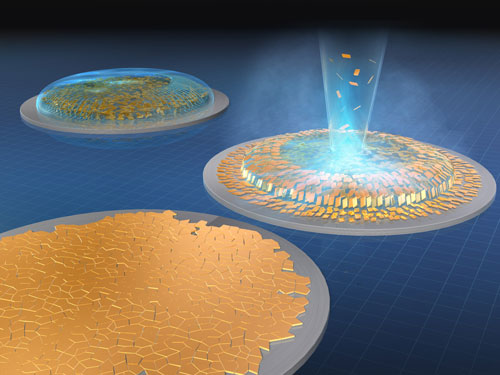
[ Vol. 67 ]
2D Electronics Could Be One Drop Away
A research team at MANA has developed a surprisingly simple method for fabricating highly organized mono- and multilayers of 2D nanosheets. All you need is a pipette and a hotplate. [...]

[ Vol. 66 ]
New EDLT-DAC Provides Insights Into High-Pressure Environments
MANA researchers have devised a way to control the carrier density in various materials under high pressure by combining an electric double-layer transistor (EDLT) with a diamond anvil cell (DAC) and applying the resulting EDLT-DAC to thin films. [...]
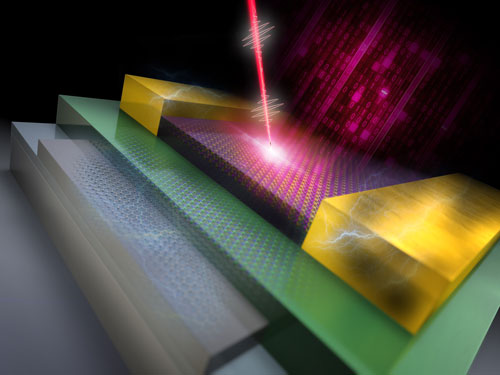
[ Vol. 65 ]
New Laser-Assisted Non-Volatile Memory Based on 2D van-der-Waals Heterostructures
A research team at MANA has demonstrated a laser-assisted non-volatile memory device based on two-dimensional van-der-Waals heterostructures. [...]
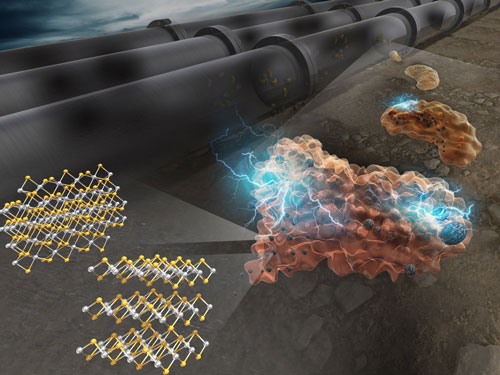
[ Vol. 64 ]
Biogenic Iron Sulfide Nanoparticles Enable Electron Uptake in Bacteria
A MANA team has identified the mechanism underlying the synthesis of long, electrically conductive pathways via iron sulfide (FeS) nanoparticles (NPs) in bacteria. This has implications in the development of new ways to inhibit microbial iron corrosion, as well as understanding the pathways of organic matter preservation in marine systems. [...]
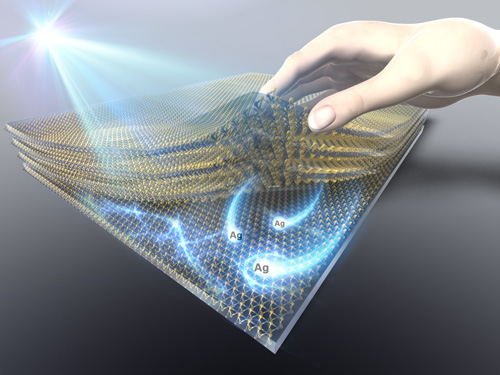
[ Vol. 63 ]
On/Off Boundary of Photocatalytic Activity between Single- and Bilayer MoS2
A team at MANA has succeeded in spatially resolving the photocatalytic activity of molybdenum disulfide (MoS2) as a model catalyst. The findings advance our understanding of the potential photocatalytic activity of 2D nanophotocatalysts. [...]

[ Vol. 62 ]
Thermoelectric Device Combined with Wavelength-selective Thermal Emitter Generates Continuous Power, Day and Night
A team at MANA has created a thermoelectric device that can generate power continuously, 24 hours a day, without the problem of voltage dropping to zero when night falls and temperatures drop. [...]
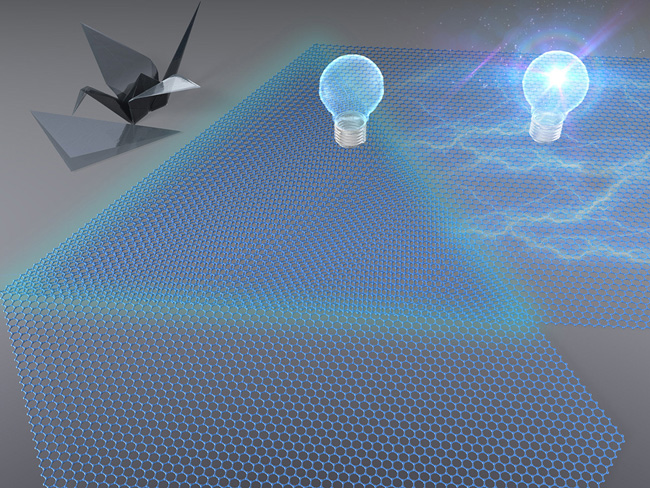
[ Vol. 61 ]
First Fabrication of fBBLG/hBN Superlattices
A team at MANA has demonstrated for the first time the fabrication of folded bilayer-bilayer graphene (fBBLG)/hexagonal boron nitride (hBN) superlattices. This achievement could pave the way for expanded applications of superlattices, such as in a variety of quantum devices. [...]
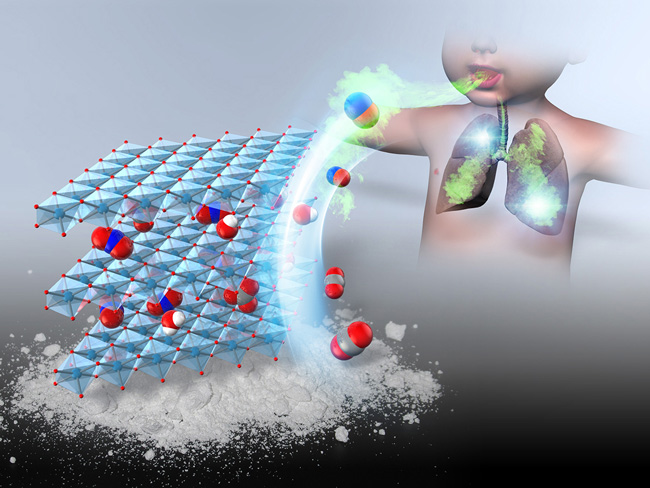
[ Vol. 60 ]
New Solid Materials Enable Broader Application of Medical Gases
Hydrogen sulfide (H2S) and nitric oxide (NO) are gases with useful bio-activities, such as anti-oxidation, anti-inflammation and vasodilation. H2S is an ingredient in hot spring and long known to have positive effects on the skin and cardiovascular system. [...]
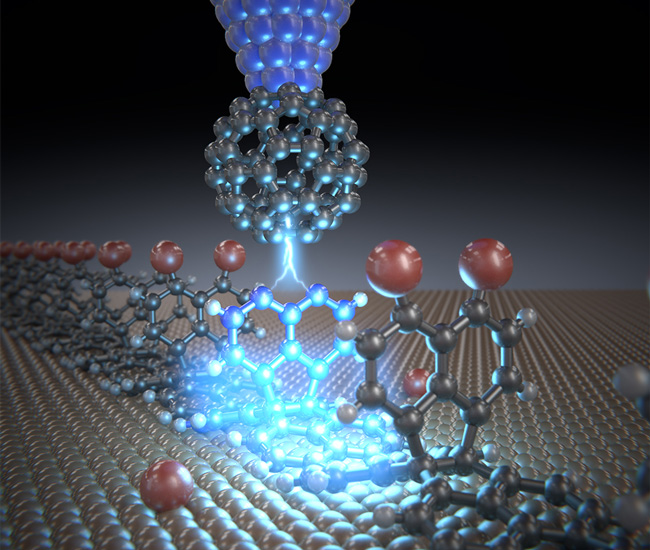
[ Vol. 59 ]
AFM’s Probe Used to Induce Chemical Reactions at Specific Sites on Single Molecule
A team at MANA has demonstrated controlled addition reactions at specific sites on a single molecule by using an atomic force microscope’s (AFM) local probe at low temperature. This work enables the synthesis of functional carbon nanostructures that cannot be obtained by conventional chemistry. [...]
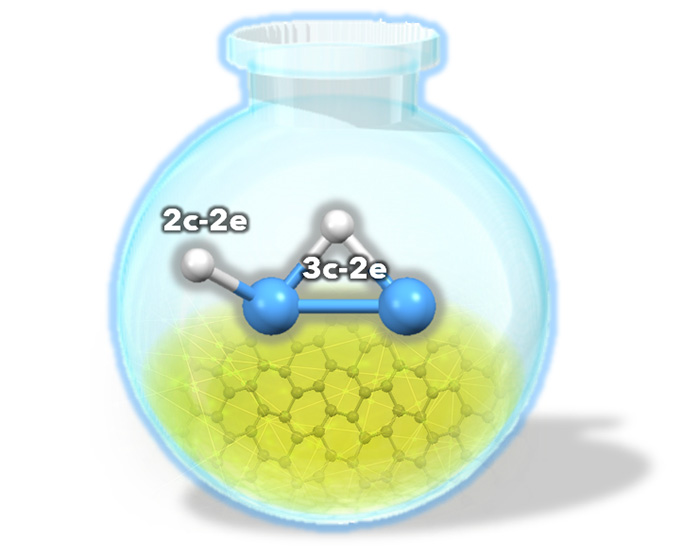
[ Vol. 58 ]
New Insights into Structure of Layered Hydrogen Borides
A team of MANA researchers has determined the structure of a layered hydrogen boride synthesized via a soft chemical route. The team found that the structure consists of B-H-B bridging bonds and B-H terminal bonds, [...]
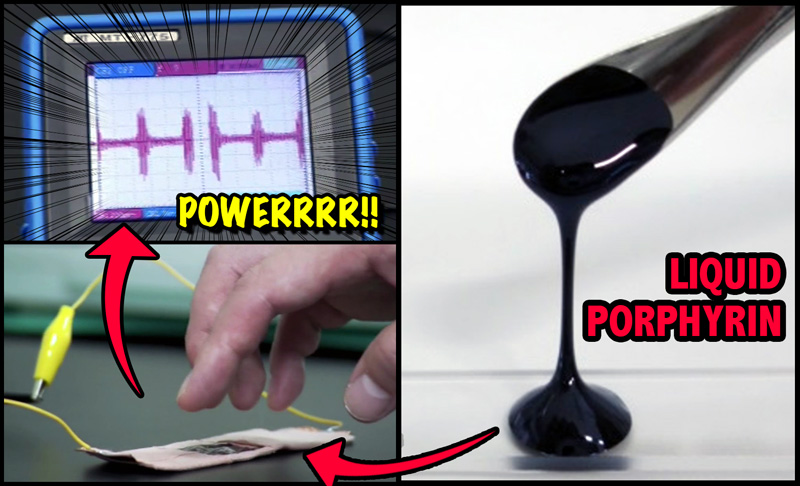
[ Vol. 57 ]
‘Liquid Electret’ Could Offer New Power Source for Wearable Electronics
Researchers at MANA have created a material that could power a new generation of wearable electronic mobile devices. [...]
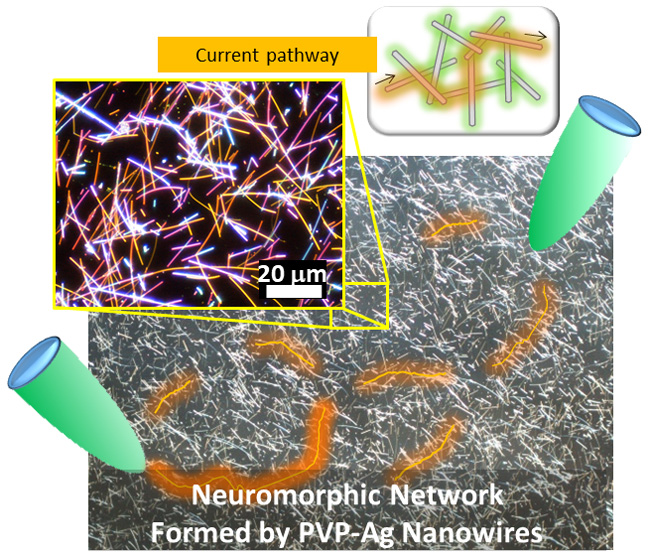
[ Vol. 56 ]
How Do Neuromorphic Nanowire Networks Find Routes to Convey Signals?
Researchers at MANA have investigated the dynamical behavior of neuromorphic systems made of memristive nano-switches connected together forming complex networks. They have shown experimentally the interplay between network topology and memristor dynamics giving rise to self-organized states. [...]
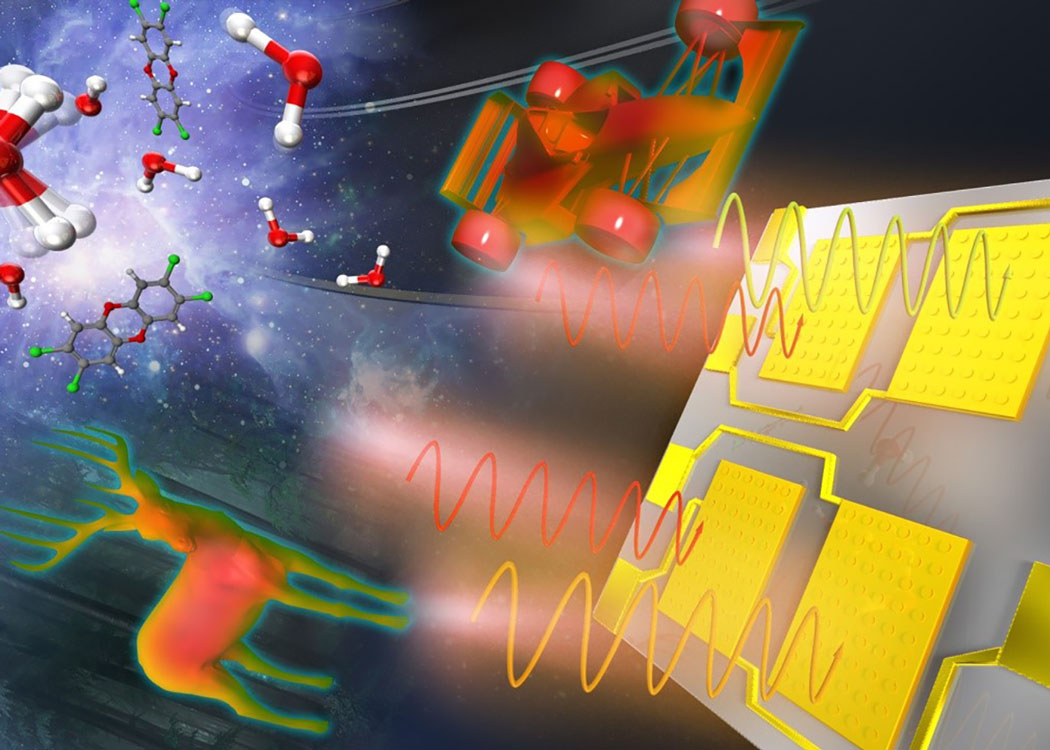
[ Vol. 55 ]
A New On-chip Sensor for Infrared Spectrography
A team at MANA has created a new type of multi-wavelength infrared sensor capable of detecting thermal radiation of specific wavelengths. It could have a range of applications, including temperature/materials-specific imaging and remote sensing of air pollution. [...]

[ Vol. 54 ]
A Low-cost, Safe and High-performance Iron Oxide Photocatalyst
A team at MANA has devised a technique for boosting the performance of iron oxide photocatalysts, which could lead to low-cost, non-toxic and environment-friendly alternatives to current materials, as well as new uses, such as photocatalytic applications in living bodies.[...]
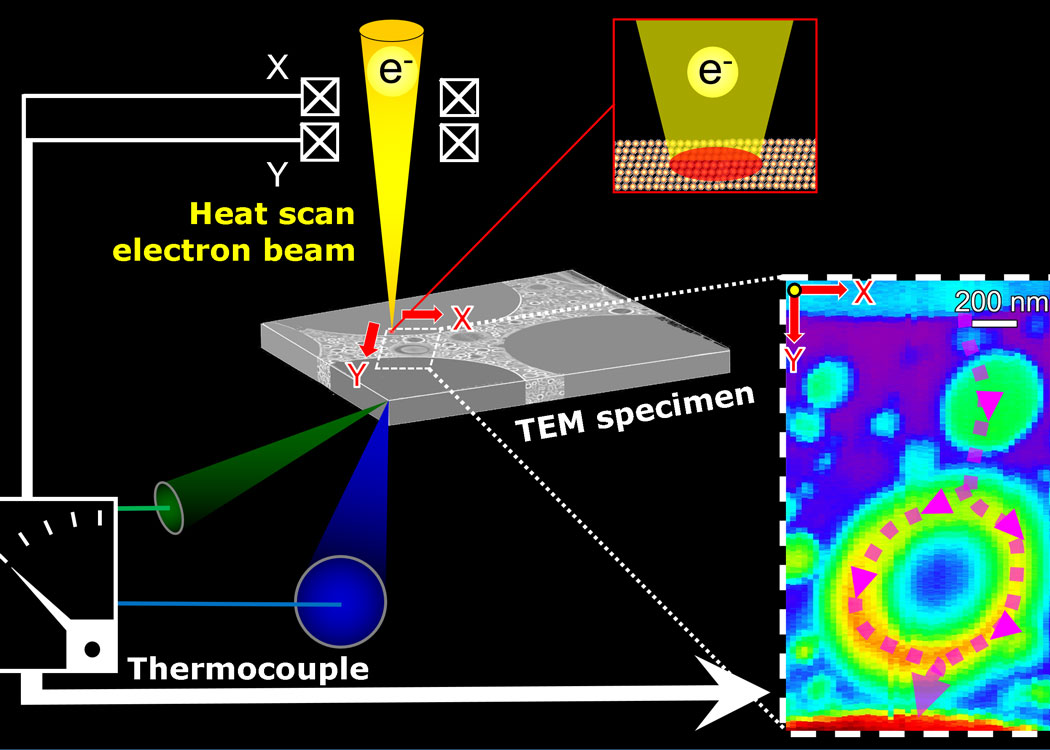
[ Vol. 53 ]
NA New Way to Observe Heat Flows at Nanoscale
A team at MANA has devised a method for visualizing heat conduction pathways at nanoscale -- a development that could lead to progress in the energy efficiency of materials. [...]
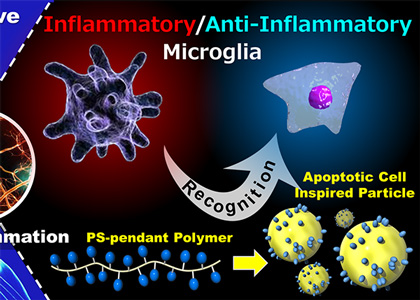
[ Vol. 52 ]
Polymeric Particles with Anti-Inflammatory Potential for Neurodegenerative Disease Treatment
One of the pathological mechanisms observed in neurodegenerative diseases in the central nervous system, including Alzheimer’s and Parkinson’s disease, is the accumulation of so-called microglia — cells that perform functions such as removing dead cells and excess synapses in the brain. When over-activated, microglia can also produce cytokines (small proteins) causing inflammation. [...]
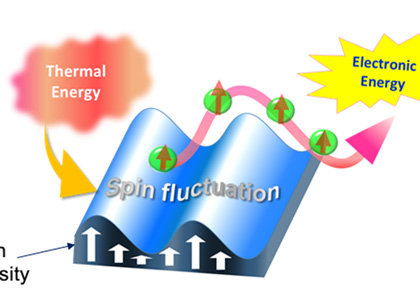
[ Vol. 51 ]
Enhanced Thermoelectric Conversion in Magnetic Materials through Spin Fluctuations
Rather than letting ‘waste’ heat dissipate, it is possible to use it and convert it into electrical energy. Such thermoelectric conversion is an important technology, especially in today’s context of alternative energy sources. Yet, achieving high recovery efficiency is difficult. [...]
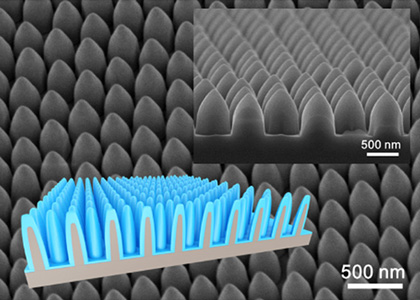
[ Vol. 50 ]
High-Performance Solar Cells Based on Silicon Nanopencil Structures
Solar cells are an important alternative energy source. The traditional solar-cell material of choice is crystalline silicon, which enables high power conversion efficiency, is stable, and has a well-established manufacturing process. Drawbacks with crystalline silicon are the high production cost and its fundamental efficiency limit. [...]
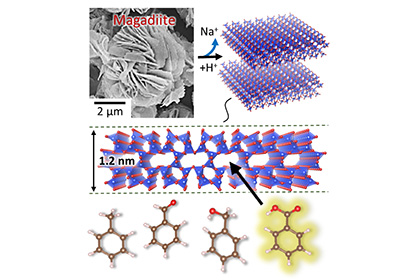
[ Vol. 49 ]
Porous Structure of a Layered Silicate with Selective Adsorption Properties Revealed
It is not always easy to precisely determine the crystal structure of layered materials — but in order to fully understand and exploit their properties, detailed structural information is needed. Magadiite is such a layered material, used as an adsorbent and a catalyst. It is known that magadiite is a kind of layered silicates: tetrahedra, each with oxygen atoms at the vertices and a silicon atom in the center, grouped in planar arrangements. [...]
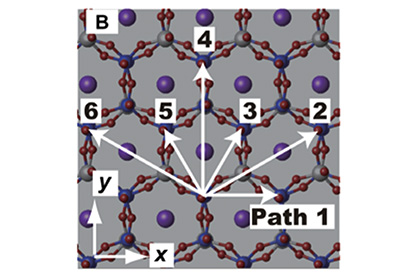
[ Vol. 48 ]
Origins of Macroscopic Friction Linked to Energy Landscape on the Nanoscale
Everybody is familiar with friction — the phenomenon plays an important role in our daily lives. Yet, although phenomenological laws exist that describe friction on the macroscale, a detailed understanding of the processes involved on the microscale is lacking. Now, Hiroshi Sakuma and Shigeru Suehara with their colleagues have studied friction forces in mica, both theoretically and experimentally, and have found the origin of molecular friction in this system. [...]
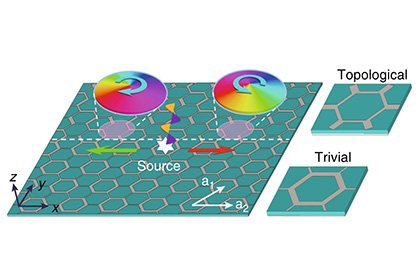
[ Vol. 47 ]
Photonic Circuits Hosting Electromagnetic Waves with Pseudospin
Metamaterials are purposely built devices mimicking structural features of normal materials, but with unusual physical properties. Photonic crystals, for example, are periodic nanostructures consisting of material components with different refractive indices. They have lattice symmetries like solids, but the constituents of the unit cell of a photonic crystal are ‘bits’ of the different bulk materials. [...]
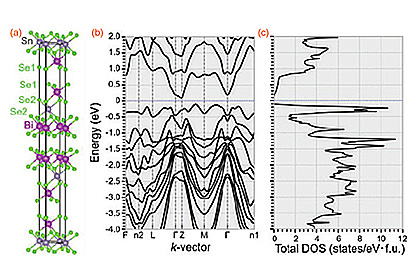
[ Vol. 46 ]
New Material That is Both a Thermoelectric and a Superconductor Identified by High-Throughput Materials Discovery
Researchers used materials discovery methods to identify and synthesize a material that has thermoelectric properties and, under pressure, is a superconductor. [...]
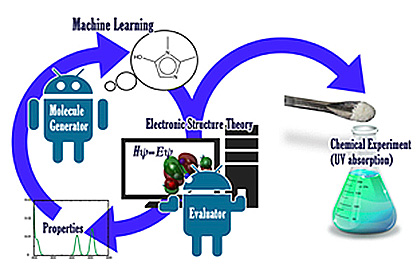
[ Vol. 45 ]
Artificial Intelligence Learns to Predict Photo-Functional Molecules
Artificial intelligence can be used to design new molecules; it is becoming a popular tool because of its potential for discovering molecules in unexplored chemical spaces, its ability to screen a huge number of potential molecules in a short amount of time and its tendency to find unconventional ways of solving problems. [...]

[ Vol. 44 ]
Ionic Devices Learn How to Make Decisions
Decision-making processes require the examination of complex data in order to effectively adapt to dynamic changes in the environment and make decisions about the most appropriate way to behave. Emulating these processes with computers requires enormous resources, so new avenues need to be explored. [...]
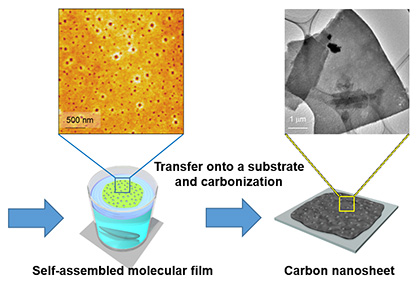
[ Vol. 43 ]
New Approach for the Synthesis of Carbon Nanosheets
Carbon nanosheets — thin materials consisting of only carbon — have many useful properties, including energy-storage and catalytic functionality. The large-scale production of carbon nanosheets, however, has been challenging. [...]
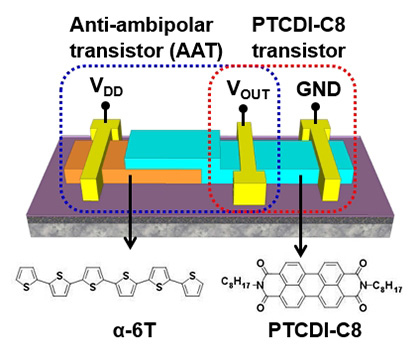
[ Vol. 42 ]
Flexible Organic Electronic Devices for Three-Valued Logic Circuitry
Wearable and flexible integrated-circuit technology is on the rise, especially in the context of the ‘internet of things (IoT)’ — devices sharing information through the internet. So-called organic field-effect transistors (OFETs), built from organic molecules, are mechanically flexible, and therefore suitable for IoT electronics. [...]
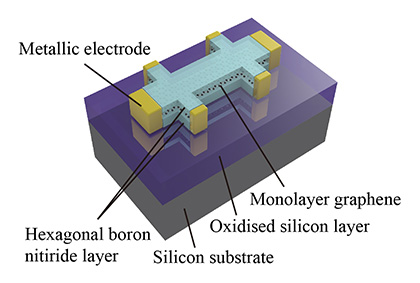
[ Vol. 41 ]
Evidence of a New Type of Quantum Effect
The quantum Hall effect (QHE) is a phenomenon that can occur in a two-dimensional electron gas — a system in which electrons can move in a plane but not perpendicularly to it. Such a system is typically realized in a heterostructure of thinly stacked layers of different semiconductors. [...]
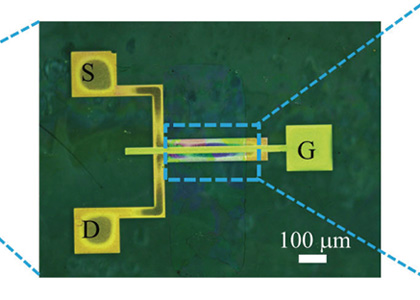
[ Vol. 40 ]
Breakthrough in Printed Electronics Enables Device Formation at Room Temperature
Printing electronic devices and circuits on flexible substrates offers the possibility of low cost, mass production of high performance organic thin film devices using technology such as “roll-to-roll”. [...]
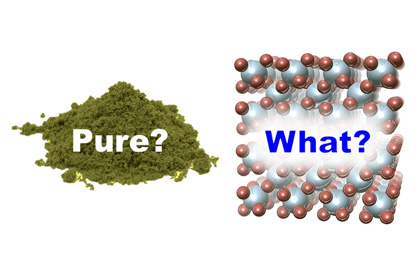
[ Vol. 39 ]
Pair Distribution Function Analysis Offers New Insights into the Structure and Identity of Nanomaterials
Satoshi Tominaka is a scientist at International Center for Materials Nanoarchitectonics (MANA) and internationally acknowledged for research on the applications of pair distribution functions (PDF) for the analysis of nanomaterials. [...]
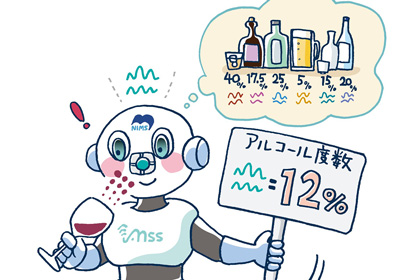
[ Vol. 38 ]
Quantifying Smell with Nanoparticles-functionalized Membrane-type Surface Stress Sensor and “Data-Driven” Analysis
Chromatography is widely used for the quantitative identification of specific components in mixtures of compounds. For example, quantifying smell requires analysis of a complex mixture composed of thousands of chemical compounds. [...]
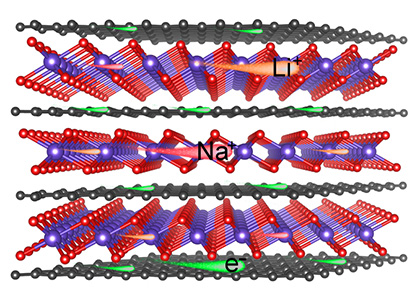
[ Vol. 37 ]
Metal Oxide/Graphene Nanosheet Composite Exhibits Unprecedented Energy Storage Properties
Single-layer metal oxide nanosheets sandwiched between graphene layers exhibit record energy storage figures of merit. [...]
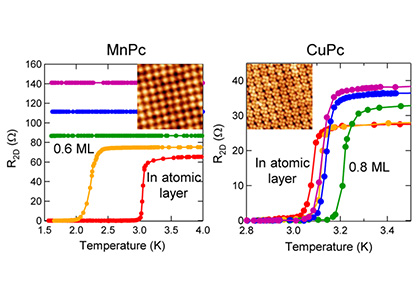
[ Vol. 36 ]
Modulating Superconductivity of Two Dimensional Atomic Layers of Indium with Charge Transfer from Self-Assembled Organic Molecules
Charge and spin transfer from copper-phthalocyanine organic molecules self-assembled on superconducting atomic layers of indium modifies the superconducting transition temperature of the indium. [...]
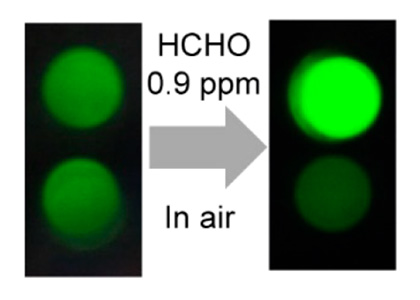
[ Vol. 35 ]
Environmental Monitoring of Air Pollution: ‘Detect to Warn’ Sensing System for Monitoring Formaldehyde
Compact ‘referenced—chemiresistive-sensors’ consisting of network-assembly of semiconducting carbon nanotubes and hydroxylamine hydrochloride enable highly selective and continuous measurement of formaldehyde for environmental monitoring. [...]
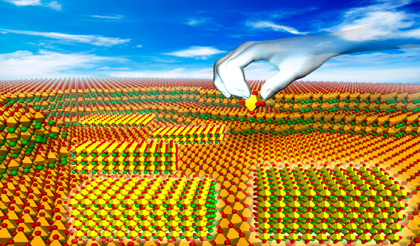
[ Vol. 34 ]
Atomically Thin Perovskites Boost for Future Electronics
WPI-MANA has developed the world's highest performance dielectric nanofilms using atomically thin perovskites. This technology may revolutionize the next-generation of electronics. [...]
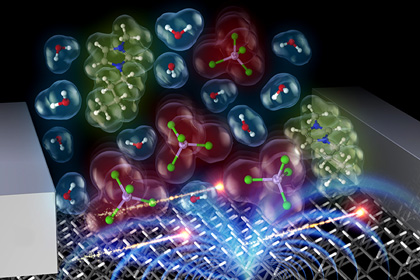
[ Vol. 33 ]
Innovative Transistors Based on Magnetically Induced Movement of Ions
Just as magnets attract iron particles in sandpits, permanent magnetics only attract one type of ion in an electrochemical solution, constituting the basis of magnetically controlled electrochemical transistors. [...]
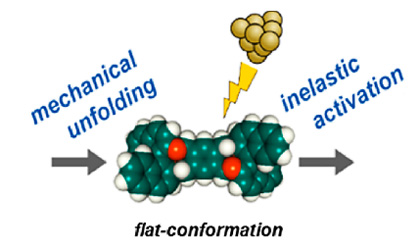
[ Vol. 32 ]
Driving Soft Molecular Vehicles on a Metallic Surface
Soft molecules deposited on metallic surfaces were driven using a scanning tunneling microscope (STM) without mechanically pulling or pushing them, but by inducing inelastic excitations with the tunneling current. [...]
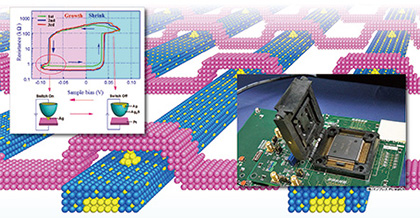
[ Vol. 31 ]
Atomic Switch Reaching Outer Space
10-year journey of the atomic switch in nanospace is finally reaching practical use in space satellites several thousand kilometers above earth. [...]
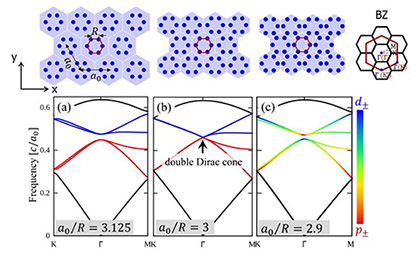
[ Vol. 30 ]
Topological Photonic Crystal Made of Silicon
WPI-MANA researchers derive topological photonic states purely based on silicon, which can lead to the development of new functions and devices through integration with semiconductor electronics. [...]
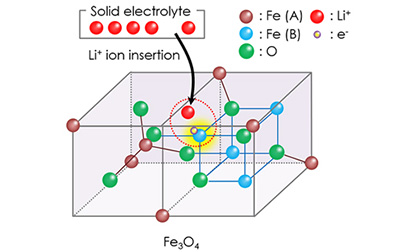
[ Vol. 29 ]
Tuning Magnetic Properties for Better Data Storage
New high-density data storage and spintronic devices could be achieved by reversibly controlling the electrical and magnetic properties of thin films. [...]

[ Vol. 28 ]
Opening the Way to Mobile Olfaction with Nanomechanical Sensors
An alliance between six organizations is setting a de facto standard for smell sensors employing a small, sensitive and versatile sensor element called the Membrane-type Surface stress Sensor (MSS). [...]
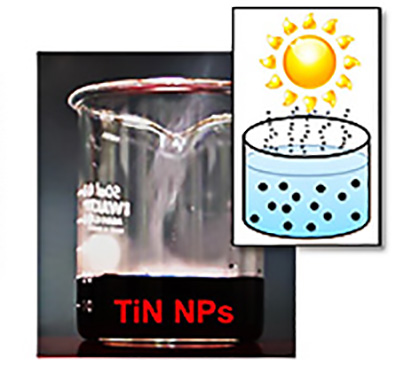
[ Vol. 27 ]
A Nanoparticle Boost for Solar-Powered Water Heating
A highly-efficient, nanoparticle-based method for heating water and generating water vapor from sunlight is demonstrated by WPI-MANA scientists. [...]
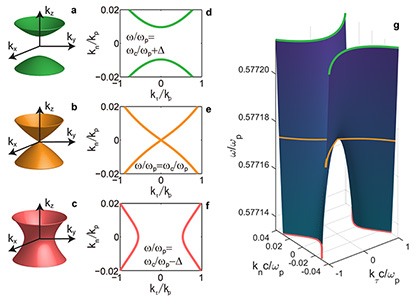
[ Vol. 26 ]
Electromagnetic Metamaterials with Zero-Refractive Index for Sub-Wavelength Photonics
A new class of optical topological transitions in electromagnetic metamaterials induced by the non-locality of the electromagnetic response is reported. [...]
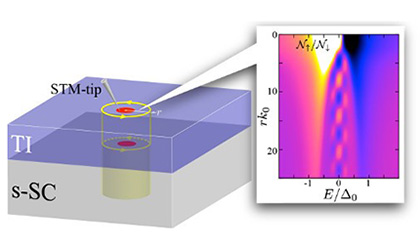
[ Vol. 25 ]
Majorana Particles in Topological Superconductors: Search for Illusive Particles Equivalent to Their Own Anti-Particles
Theoreticians at MANA report on the existence of Majorana-type particles based on analysis of independent scanning tunneling spectroscopy measurements on thin film of topological insulator bismuth telluride on substrate of superconducting niobium selenide. The findings are important for robust topological quantum computing. [...]
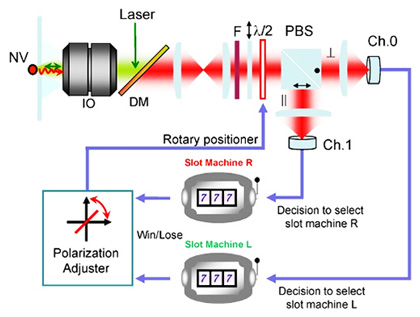
[ Vol. 24 ]
Autonomous Decision-Making by Single Photons
Efficient and adaptive autonomous decision-making has been implemented based on a purely physical mechanism exploiting the quantum nature of photons. [...]
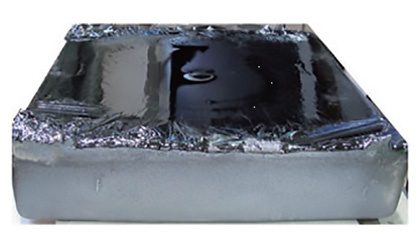
[ Vol. 23 ]
Seeding Better Efficiencies in Monocrystalline Silicon Solar Cells
New ‘single-seed cast method’ for producing high quality monocrystalline solar cells has tremendous potential for the manufacture of low cost, high efficiency silicon solar cells. [...]
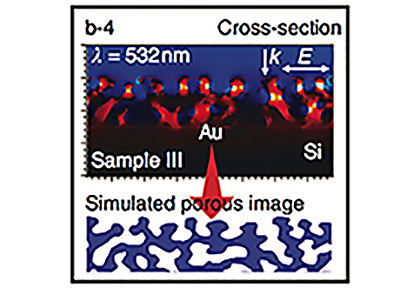
[ Vol. 22 ]
Holes in Gold Enhance Molecular Sensing
Electrochemical techniques produce tuneable porous gold films, where the empty spaces enhance light scattering and sensing signals. [...]
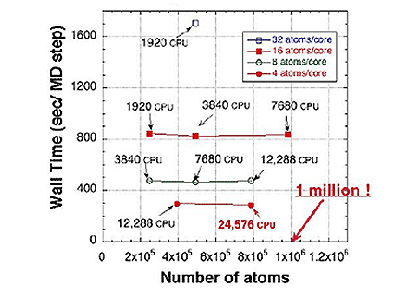
[ Vol. 21 ]
Supercomputing in Materials Science: First-Principles Simulations of Large Molecules
Large-scale calculation capable of handling material systems containing 100 to 1,000 times more atoms than conventional methods. [...]
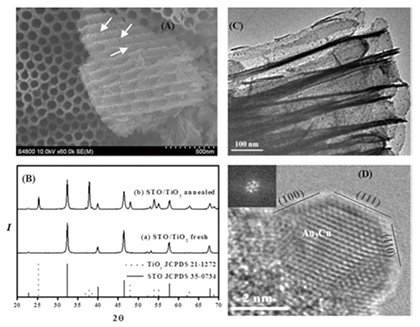
[ Vol. 20 ]
Hydrocarbon Photocatalysts Get in Shape and Go for Gold
A combination of semiconductor catalysts, optimum catalyst shape, gold-copper co-catalyst alloy nanoparticles and hydrous hydrazine reducing agent enables an increase of hydrocarbon generation from CO2 by a factor of ten. [...]
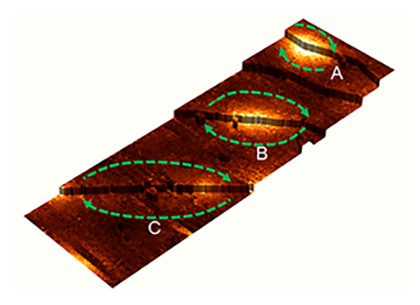
[ Vol. 19 ]
Visualizing Superconductive Coupling over Atomic Steps
Scanning tunnelling microscopy imaging under differing magnetic fields gives fundamental insights into the behavior of supercurrents and vortices on the surface of indium-doped silicon films. [...]
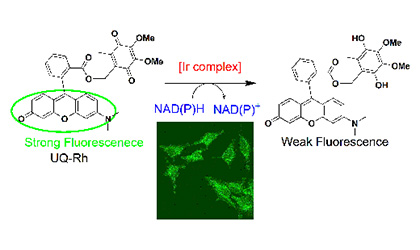
[ Vol. 18 ]
Intracellular Imaging Gets Interactive
A so-called bioparallel chemistry approach is successfully used to image and activate an essential metabolism compound inside a cell. [...]
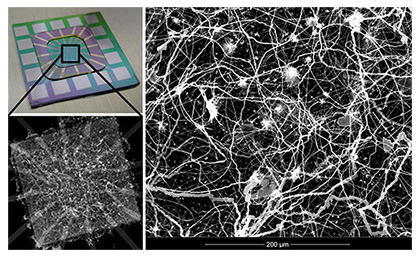
[ Vol. 17 ]
Atomic Switch Networks for Cognitive Technology
A self-organized network of inorganic synapses provides a unique approach toward the development of brain-like computers. [...]
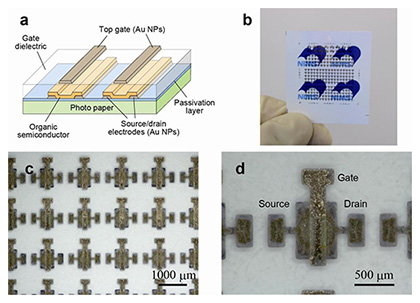
[ Vol. 16 ]
A Cool Approach to Flexible Electronics
A nanoparticle ink that can be used for printing electronics without high-temperature annealing presents a possible profitable approach for manufacturing flexible electronics. [...]
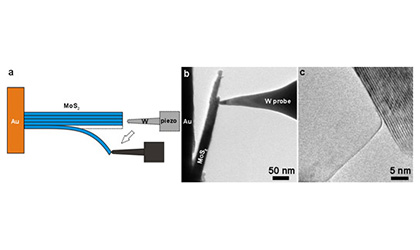
[ Vol. 15 ]
Revealing the "Scotch-Tape" Technique Mechanism
First In-Tandem Experimental and Theoretical Modeling of a Famous “Scotch-Tape” Technique for Making Two-Dimensional Graphene-like Nanosheets. [...]
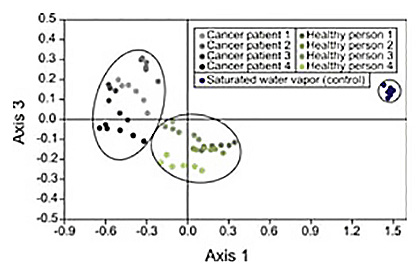
[ Vol. 14 ]
Nanomechanical Sensors Detect Cancer from Breath
An array of functionalised membrane-type surface stress sensors (MSS) distinguishes cancer patients from healthy people through a signature response to breath samples. [...]
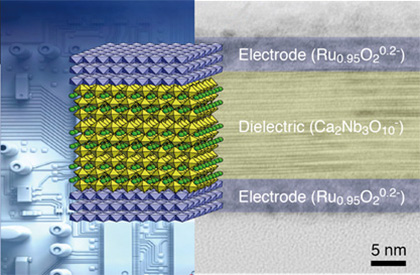
[ Vol. 13 ]
Oxide Nanosheets Trump Current State-of-the-Art Capacitor Materials
Researchers developed ultrathin high-performance capacitors using LEGO-like game of oxide nanosheets. [...]
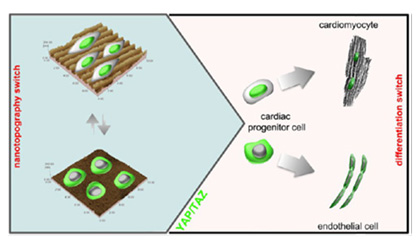
[ Vol. 12 ]
Heart Cells Respond to Stiff Environments
Proteins associated with the regulation of organ size and shape have been found to respond to the mechanics of the microenvironment in ways that specifically affect the decision of adult cardiac stem cells to generate muscular or vascular cells. [...]
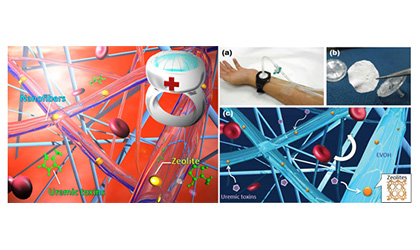
[ Vol. 11 ]
A Simple Way to Treat Kidney Failure
A new technique for purifying blood using a nanofiber mesh could prove useful as a cheap, wearable alternative to kidney dialysis. [...]
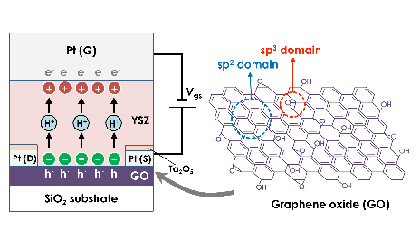
[ Vol. 10 ]
In Situ Bandgap Tuning of Graphene Oxide Achieved by Electrochemical Bias
The ability to modulate the physical properties of graphene oxide within electronic components could have numerous applications in technology. [...]
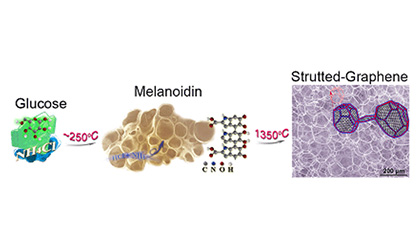
[ Vol. 9 ]
3D Strutted-Graphene by a Sugar Blowing Method
Robust, highly conductive 3D graphene structures for use in super-capacitors, through a method inspired by blown sugar, created. [...]
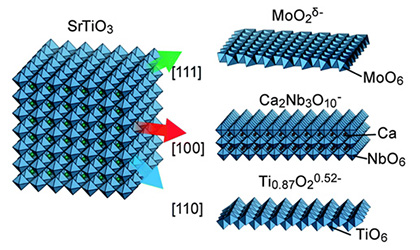
[ Vol. 8 ]
Crystal Film Growth: Nanosheets Extend Epitaxial Growth Applications
Molecularly thin two-dimensional crystals can alleviate the lattice matching restrictions of epitaxial crystalline thin film growth, as reported by researchers in Japan. [...]
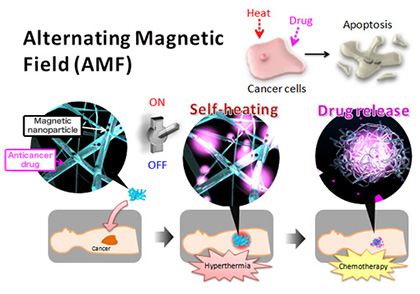
[ Vol. 7 ]
Smart Anticancer Nanofibers: Setting Treatments to Work Together
Incorporating magnetic nanoparticles and an anticancer drug into crosslinked polymer nanofibers presents a twofold treatment for fighting cancer with diminished side effects. [...]
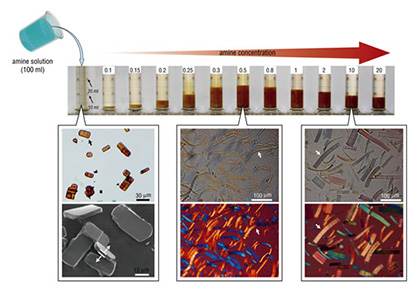
[ Vol. 6 ]
Inorganic Materials Display Massive and Instantaneous Swelling and Shrinkage
The first observation of massive swelling and shrinkage of inorganic layered materials like a biological cell provides insights into the production of two-dimensional nanocrystals. [...]
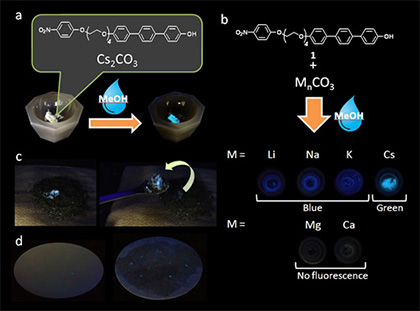
[ Vol. 5 ]
Detecting Caesium with Naked Eyes
'Micrometre-level naked-eye detection' of caesium ions, a major source of contamination in the vicinity of radioactive leaks, is demonstrated in a material developed by researchers in Japan. [...]
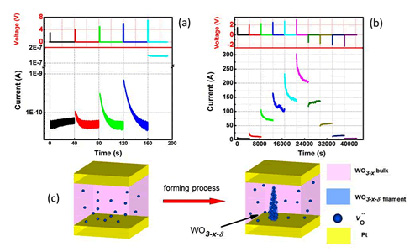
[ Vol. 4 ]
On-Demand Synaptic Electronics: Circuits that Learn and Forget
Researchers in Japan and the US propose a nanoionic device with a range of neuromorphic and electrical multifunctions that may allow the fabrication of on-demand configurable circuits, analog memories and digital–neural fused networks in one device architecture. [...]
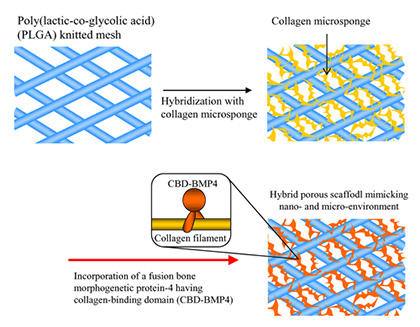
[ Vol. 3 ]
Bone Tissue Engineering: Attaching Proteins for Better Regeneration
Researchers in Japan demonstrate a new protein binding approach for effectively promoting bone regeneration. Current treatments for bone defects and bone tissue regeneration have significant limitations. Now a new method that immobilizes a fusion protein in a hybrid collagen-polymer supportive scaffold shows promise for bone tissue engineering. [...]
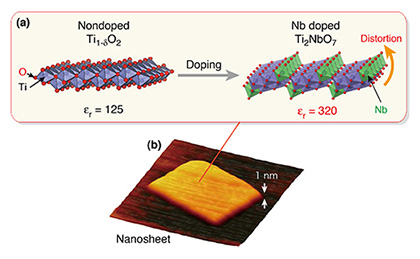
[ Vol. 2 ]
High-Performance Thin Film Boost for Electronics Research
MANA researchers have developed the world's highest performance thin-film capacitors using a new high-permittivity (high-κ) dielectric sheet with molecular-level thickness (~1 nm). This technology may revolutionize the next-generation electronics. [...]
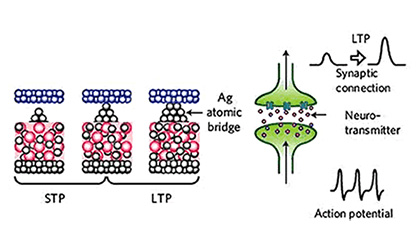
[ Vol. 1 ]
Atomic Nano-Switches Emulate Human Memory
MANA scientists discover that inorganic synapses mimic the human brain. [...]



























































































